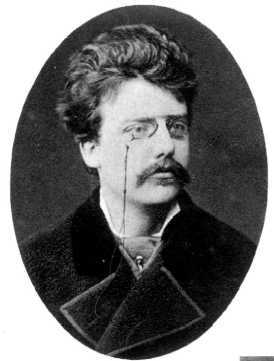The directory «Plots»
Jurčič Josip
(1844—1881)

Josip Jurčič was born one hundred and fifty years ago (on March 4, 1844) in Muljava, a small village near Višnja Gora and the famous Stična monastery, in the family of a poor crofter and coachman of the Stična monastery. After the dismal beginning of his education at the village school in Krka and at the somewhat better school in Višnja Gora, he was successful at the elementary and later at the grammar school in Ljubljana. As a grammar school boy he was an avid reader and began publishing his essays in the newspapers of that time. He first drew attention to himself with his "Spomini na deda" (Memories of My Grandfather) published in Bleiweis's "Novice", and especially with his historical narrative dealing with the Turkish raids into our territory in the l6th century, under the title "Jurij Kozjak, slovenski janičar" (Jurij Kozjak, a Slovene Janissary) (1864), which he published as a seventh-grade student with St. Mohor's society in Klagenfurt.
After graduation, he studied classical and Slavic philology at the university of Vienna, but he soon abandoned his studies and for the lack of funds entirely devoted himself to writing. He published his literary works predominantly with Anton Janežič, a publisher from Klagenfurt, in his "Slovenski glasnik" (Slovenian Herald) and Cvetje iz domačih in tujih logov" (Flowers from the domestic and foreign groves). It is in these two magazines that he published his important works: the narrative "Domen", the first Slovene novel "Deseti brat" (The Tenth Brother), the historical narrative "Hči mestnega sodnika" (The Daughter of the City Judge), "Nemški valpet" (The German Bailiff), "Kozlovska sodba v Višnji Gori" (The Blunder Judgment in Višnja Gora), etc., all of them with a strong romantic inspiration.
In 1868 he published in the almanac "Mladika" - an edition prepared jointly by himself and his friends Josip Stritar and Fran Levstik - his best realistic narrative "Sosedov sin"(The Neighbour's Son), for which he took the subject from the real life of the young country folks of his time.
Later on Jurčič also devoted himself to journalism. He started as a journalist for the paper "Slovenski narod" (The Slovenian People) in Maribor on its very establishment, then moved for a limited period of time to "Südslavische Zeitung" in Sisak, and then returned again to "Slovenski narod" in Maribor. In 1872 he moved the newspaper to Ljubljana and a year later reorganized it into Slovenia's first daily. Beside his journalistic work he also went into politics and became one of the prominent members of the Young Slovenian movement.
After 1875 he again dedicated more time to his literary work. He published two novels: "Doktor Zober" and "Cvet in sad" (The Flower and the Fruit). Beside short realistic prose ("Telečja pečenka" /Roast Veal/, "Pipa tobaka" /Pipe of Tobacco/, "Božidar Tirtelj") he also tried his hand at drama, where his friend Levstik rewrote to a great extent his first Slovene tragedy "Tugomer", and several days before his death he also finished "Veronika Deseniška". Unfortunately, his historical narrative "Rokovnjači" (The Brigands), which he started publishing in instalment in the new magazine "Ljubljanski zvon", was left unfinished. He died of pneumonia in the prime of his life in 1881. He was buried at Navje, Ljubljana's old cemetery.
Jurčič's literary work, which is for the most part strongly romantic and only in the description of country life in Dolenjsko in the first half of the l9th century also already realistic, became very popular with the Slovene reading public, which is still evidenced by mass reprints of his works in Slovene and numerous translations, where "Jurij Kozjak" and "Deseti brat" appear among the most frequently translated Slovene literary works in general.
In Muljava, which the writer often used as the setting of his works, his descendants look with great care after the house in which he was born and which has been transformed into a museum. At the same time it represents an important example of ethnographic heritage among the humble homesteads of Dolenjsko from the previous century.
Slovenia, 1994, The illustration of the story «Rokovnjači»